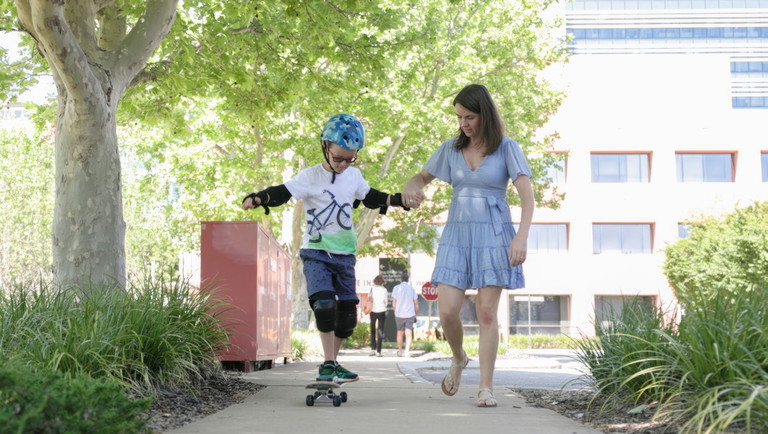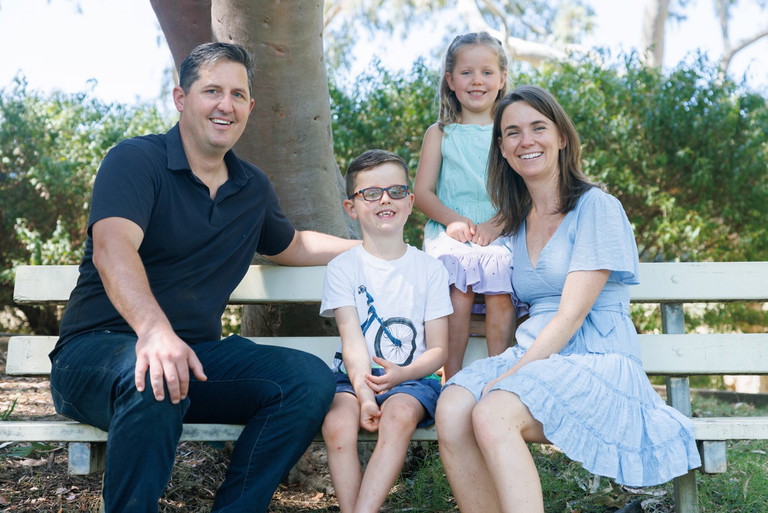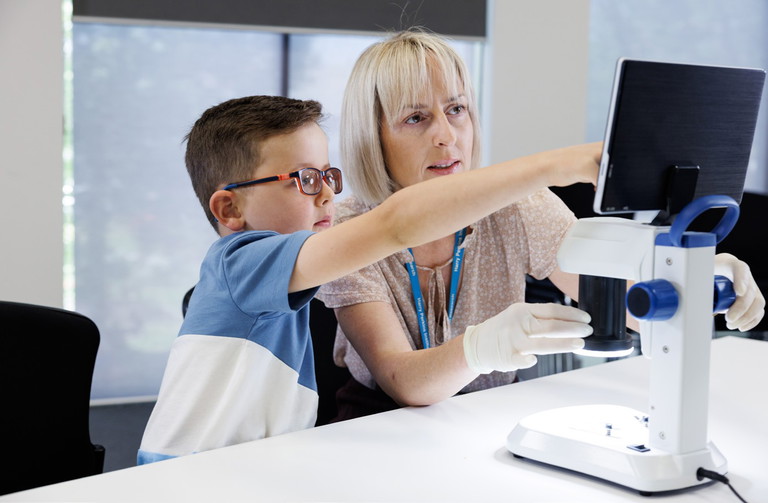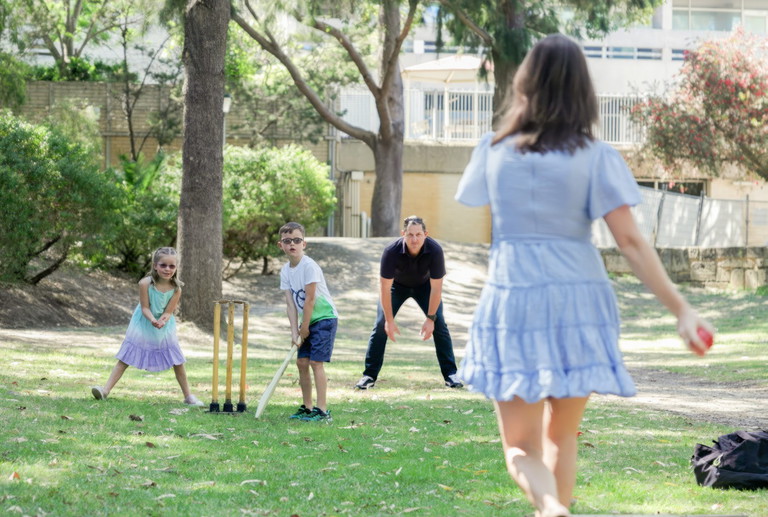mistory

Beyond the Prescription
The Reality of Early-Onset Myopia
When eight-year-old Angus Greeff was diagnosed with early-onset myopia six years ago at the age of two, his mother Saskia had little understanding of what lay ahead. Like many parents, her family’s history of “short-sightedness” seemed straightforward – you get glasses, you cope, life goes on. Today, as Angus thrives as an active primary school cricket player with stable vision thanks to atropine therapy, their story illustrates both the challenges of living with myopia and the incredible progress being made to limit its long-term impact.
WRITER Melanie Kell
A GRANDMOTHER’S KEEN EYE
The journey to diagnosis began not in a clinic, but during family video calls. Saskia’s mother, watching her grandson through a smartphone screen, noticed something that concerned her.
“My mum would look at him looking at books during our WhatsApp video calls and she’d say, ‘Don’t you think he’s looking at them too closely?’” recalled Saskia, a physiotherapist from Perth. “I hadn’t really thought about it, to be honest.”
The family history was there – Saskia herself had undergone laser surgery and lens implants for her myopia, following a pattern that included her mother and grandfather. Yet like many families, they had simply accepted their “shortsightedness” as an inevitable part of life, without truly understanding myopia as a progressive eye condition requiring active management.
Additional signs began to emerge. Twoyear-old Angus was falling over frequently, accumulating bumps and scratches on his head that left his parents wondering if this was typical toddler clumsiness or something more concerning.
“I asked the daycare if they thought this was normal. He was my firstborn, so I didn’t know if this is just what little kids do.”
When daycare staff confirmed that Angus seemed to fall more than other children, combined with his grandmother’s observations about his near-vision behaviour, Saskia sought professional assessment.
EARLY DIAGNOSIS CHALLENGES
The initial optometry visit highlighted the complexities of diagnosing myopia in very young children. As a toddler, Angus was at the limits of conventional testing methods.
“Because he was only two, I don’t think they were hugely confident,” Saskia recalled. “They could recognise that he had myopia like me, but I don’t think they were confident in actually giving a prescription or anything like that.”
This led to a referral to Dr Antony Clark at the Lions Eye Institute, where Saskia was impressed by the specialist’s approach to paediatric assessment.
“At the first appointment, they didn’t use any of the machines because he was so little,” she explained. “Dr Clark just held up little lenses and sang little songs to him and shone the light through, obviously looking for that refraction onto the back of the eye. I was blown away at how quickly he did it and simply, without using any really complicated technology that my two-year-old wouldn’t have been able to sit through.”
The diagnosis was clear, but the prescription strength was sobering. While Saskia had always considered her own minus-seven prescription significant, Angus was starting at minus-nine.
“The realisation that atropine should be administered at bedtime came after several difficult experiences”
“I was a bit shocked by that,” she admitted. “His prescription was much stronger than mine or my mum’s.”
THE TREATMENT EVOLUTION
Initially, Angus was fitted with glasses, beginning what would become a familiar pattern of regular prescription changes as his myopia progressed. However, the introduction of atropine therapy approximately two years later marked a turning point in his treatment.
Angus’ prescription quickly stabilised and since then, “it’s only changed marginally, which I think has been amazing”, said Saskia. “Sometimes at appointments, Dr Clark has said we could change the glasses or not. There hasn’t been a significant change at all.”
Like many families new to atropine therapy, the Greeffs experienced an initial learning curve that highlights the importance of clear patient education.
“At first, I don’t know if we missed a piece of information or someone didn’t give it to us, but we were administering atropine drops in the morning,” Saskia laughed. “My poor child was going out in the Australian sun with dilated pupils.”
“The realisation that atropine should be administered at bedtime came after several difficult experiences.”

“He would wear dark glasses afterwards – we’ve always given him transitions lenses… but I’d have to make him walk with his eyes closed, holding my hand. Only later I think we read the label and thought, ‘We’re supposed to be doing this at night’.”
Now administered properly before bedtime, eight-year-old Angus has adapted well to the routine. The family has even developed their own techniques for drop administration.
“I do it with his eyes closed and drip it into the corner of his eyes, then he blinks, and it goes in,” Saskia explained. “My husband makes him keep his eyes open and drops it in. I asked Angus which way he prefers, and he said, ‘I don’t really mind either way’.”
BEYOND CLINICAL MANAGEMENT
One of the most striking aspects of Angus’ story is how well he has adapted to life with significant myopia, challenging some assumptions about how refractive error impacts childhood activities.
“I was always terrible at sport – I just don’t have the hand-eye coordination – and I always blamed that on my myopia,” Saskia admitted. “But Angus has great hand-eye coordination. He’s really good at cricket and tennis, and he’s fantastic at sports. I can’t blame it on my myopia anymore because it doesn’t affect him.”
The family’s approach to frame selection has been practical and successful. They discovered Nano glasses, made from hard plastic with flexible rubber hinges that allow the arms to fold backwards and bend in multiple directions.
“We’ve been lucky with these glasses,” Saskia observed. “He has broken one side of the pair that he’s got now; we’ve had to tape it back together because he’s getting his eyes checked in about two months. But other than that, all his glasses have been quite durable.”
SOCIAL INTEGRATION AND ACCEPTANCE
A particularly encouraging aspect of Angus’ experience has been the social acceptance of glasses-wearing among his peer group – a significant change from previous generations.

Angus with his father Juan, sister Cira, and mother Saskia.
“At school now, so many kids are wearing glasses,” Saskia said. “I think that teasing element of kids wearing glasses just isn’t there so much anymore. Even kids who aren’t wearing glasses day-to-day are wearing them in the classroom, so kids aren’t getting teased. In fact, I think some kids want to wear glasses.”
However, some practical challenges remain. Team sports equipment designed for the general population doesn’t always accommodate prescription eyewear.
“Their cricket coach bought all the boys these fancy cricket sunglasses, but because Angus is the only one on the team who needs prescription lenses, he can’t really wear them,” Saskia explained. “He has to balance them over the top of his glasses for the team photo.”
LIFESTYLE CONSIDERATIONS AND MANAGEMENT
The family received guidance about outdoor activity and screen time, recommendations that aligned well with their existing lifestyle.
“We were probably given that advice, but I didn’t need to change much because that’s sort of how we are anyway,” said Saskia. “I’m a physio, so I’ve always wanted my kids to be out and about. We do loads of stuff – we’re at the beach, playing sports, tennis, bike rides, at playgrounds.”
Their approach to screen time has been consistently restrictive.
“I’ve always been quite strict with screen time. My thought is to fight the good fight for as long as I can, because eventually they’re going to be on screens a lot,” she explained. “At one point, we only watched an hour of cartoons on Saturday and Sunday. Even now, they don’t really watch TV during the week.”
One surprising revelation was learning about the potential impact of near work, including reading.
“I was surprised that reading books was also contributing to myopia,” Saskia admitted. “That shocked me a little bit. I’m a big reader and my kids are big readers too because we’ve avoided screen time. I was like, ‘Oh man, that’s not fair’.”
Despite this knowledge, the family has chosen not to restrict reading significantly.
“I don’t tend to manage the book reading too much because I love it so much and think it’s really good for them,” she said. “But we still make sure they’re playing sport and doing stuffoutside.”
LONG-TERM OUTLOOK AND REASSURANCE
Six years into their myopia management journey, Saskia’s family feels confident about Angus’ long-term prognosis.
“I think being a healthcare professional, I have a lot of faith in the system,” Saskia explained. “Dr Clark is wonderful, and the Lions Eye Institute has been great for us. As long as we stick to our six-monthly check-ups, it’s very reassuring.”
The stability achieved with atropine therapy has been particularly encouraging, given her own experience of myopia progression.
“I know my eyesight deteriorated until I was in my mid-20s, so seeing that his is not doing that right now really makes me feel comforted,” she said. “I was concerned because his prescription was much stronger than mine or my mum’s, but the fact that it’s staying pretty level is very reassuring.”
THE BROADER IMPACT: RESEARCH AND ADVOCACY
The family’s experience has extended beyond personal management to contributing to broader myopia research and awareness efforts. They’ve participated in advisory panels and research studies, helping to shape understanding of patient and family experiences.
“My husband and I were asked to be on an advisory panel for some of the myopia research in WA,” Saskia explained. “It’s been quite nice to hear about research studies that are ongoing.”
These experiences have broadened their understanding of myopia as a global health challenge, particularly through exposure to international research.
“One of the panel members talked about research from China, where they have such a high incidence of myopia that their research is ahead of ours,” she noted. “It was fascinating to learn about how Asian parents tend to focus on different measures of myopia and axial lengths. I didn’t even know any of this language before.”
Angus himself has become comfortable participating in research and awareness activities, including video testimonials for other families beginning myopia management treatment.

Dr Jessica Mountford with Angus. Dr Mountford’s research focusses on the genetic and environmental risk factors that interact and contribute to the progression of myopia.
“He’s quite happy to participate in all these things and chat to people about it,” his mother said. “I always ask him if he’s happy to do videos and participate in research, and he’s been fine with it all.”
REFLECTING ON PROGRESS
Perhaps most telling is Saskia’s reflection on how far myopia management has progressed since her own childhood.
“I wish we’d had this when we were kids,” she said. “It’s incredible. It just shows what research can do.”
Her sentiment captures the fundamental shift in myopia management from passive acceptance to proactive intervention. As a result, today’s families have access to treatments that can meaningfully slow progression, prevent the onset of complications, and preserve long-term eye health.
“These experiences have broadened their understanding of myopia as a global health challenge, particularly through exposure to international research”
CLINICAL IMPLICATIONS
Angus’ story illustrates several key points for practitioners managing paediatric myopia.
Early detection matters. Family history combined with behavioural observations led to diagnosis at age two, enabling early intervention that has proven highly effective.
The value of specialist referral. While initial optometric assessment identified the condition, specialist paediatric expertise was crucial for confident diagnosis and ongoing management in such a young patient.
Treatment evolution. The progression from glasses alone to combination therapy with atropine demonstrates the importance of ongoing monitoring and treatment adjustment.

Patient education. The initial confusion about atropine timing highlights the critical importance of clear, comprehensive patient education, particularly around medication administration.
Lifestyle integration. Successful myopia management extends beyond clinical interventions to encompass lifestyle factors, family dynamics, and long-term planning.
Social considerations. Understanding the broader impact of myopia on childhood activities, peer relationships, and family life helps practitioners provide more comprehensive care.
LOOKING FORWARD
As Angus continues to thrive with stable myopia under ongoing atropine therapy, his story represents both the challenges and opportunities in contemporary myopia management. His experience demonstrates that with early intervention, appropriate treatment, and the support of a strong family, children with significant myopia can lead full, active lives while maintaining long-term eye health.
For practitioners, Angus’ journey serves as a reminder that behind every prescription and treatment protocol is a child and family navigating the realities of chronic condition management. Success is measured not just in dioptres stabilised, but in cricket matches played, books read, and the confidence of a young person who sees his glasses not as a limitation, but simply as part of who he is.
The evolution from his grandmother’s concerned observations during video calls to today’s stable, well-managed myopia represents the best of modern paediatric eye care – early detection, evidence-based intervention, and comprehensive family-centred management that prioritises both vision and quality of life.
Out of the Mouths of Babes
For eight-year-old Angus Greeff, life with early onset myopia is all he knows, and he wants to make sure that as many people as possible know about myopia too.
In conversation with mivision, he said that’s because “telling them my story might make them realise something is wrong with their own eyes” and then they can have their vision corrected.
“I’ve been on TV, YouTube, and sometimes I go to meetings – it’s fun times,” he said with a genuine smile in his voice.
While eye exams are “not really fun – they’re pretty serious”, he said daily eye drops are easy (“there’s no sting”), and wearing glasses doesn’t bother him at all. “It’s OK, I’m used to it – I’ve been wearing glasses for years and all my friends wear them too.”
Besides that, vision correction simply makes sense because “my eyesight without glasses is blurry, so I just wear them all the time”.
As for taking his ophthalmologist’s advice to spend time each morning playing outside; for Angus, that, of course, is the best advice of all.